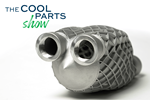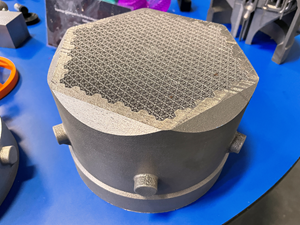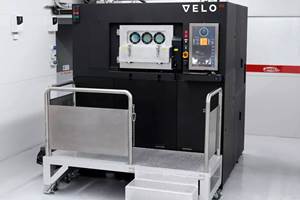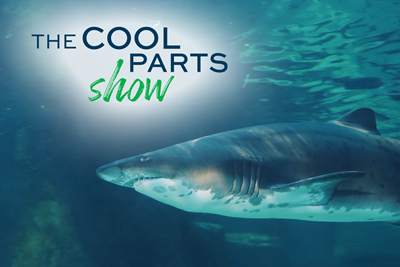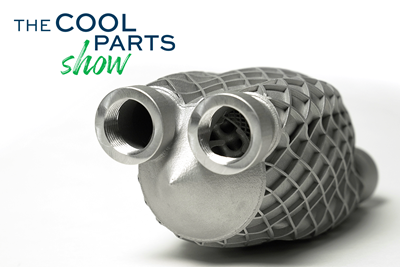[Correction: Text embedded in this video has an incomplete name for our nTopology expert. His full name is Alkaios Bournias Varotsis.]
Electrification of vehicles can bring new manufacturing challenges, as the Dynamis PRC student team at the University of Milan discovered when transitioning its Formula SAE race car from internal combustion to battery power. The inverter that converts the DC power from the battery to AC to drive the motors must be kept within a specific temperature range; to maintain this range, the electric race car incorporates a fluid-cooled heat exchanger called a cold plate. The 3D printed device produced by M4P was designed by Puntozero using nTopology software. Regular and irregular lattice structures as well as biomimicry helped reduce the size and weight of the cold plate from an earlier machined design while increasing surface area, saving energy in directing the flow of coolant, and improving cooling performance.| This episode of The Cool Parts Show brought to you by Carpenter Additive
The Cool Parts Show is a video series from Additive Manufacturing Media that explores the what, how and why of unusual 3D printed parts. Watch more here.
Have a cool part to share? Email us.
Related Resources
- More on the creation of this cold plate
- The Dynamis PRC student racing team at the University of Milan
- Formula SAE racing competition for college students
- Design firm Puntozero
- Materials supplier and additive manufacturer M4P
- nTopology design software
- What is laser powder bed fusion?
- Another episode where 3D printing reduced weight for an electric vehicle
- Another use of nTopology for an unconventional lattice
- Another cool part using shark skin-inspired features, plus our Shark Week coverage of ongoing biomimicry research and applications
Transcript
Stephanie Hendrixson
Electric vehicles are heating up and we need better ways to keep them cool. All about this part for an electric race car on this episode of The Cool Parts Show. This episode of The Cool Parts Show is brought to you by Carpenter Additive.
Peter Zelinski
We're at the company's powder production facility in Athens, Alabama.
Stephanie Hendrixson
Specifically, we are standing on top of the Z1, the company's largest vacuum atomizer for producing metal powders.
Peter Zelinski
Want to know how to make metal powder for additive manufacturing? Stick around after the episode. I'm Pete.
Stephanie Hendrixson
I'm Stephanie.
Peter Zelinski
Welcome to The Cool Parts Show.
Stephanie Hendrixson
This is our show all about cool, unique, interesting, figuratively and literally cool parts.
Peter Zelinski
Literally cool. Okay. So I think that's a clue that we're going to talk about thermal transfer here. This is an interesting part. I don't know if this is an adjective. This is very lattice-y
Stephanie Hendrixson
This is a very lattice-y part. And in fact, there are two different lattices. And we're going to talk about both of them. We are going to talk about thermal transfer, all that good stuff.
Peter Zelinski
Okay. What is this?
Stephanie Hendrixson
So this part is a cold plate. So it's sort of a fluid cooled heat exchanger. It was created for an electric racecar that's being developed by some students at the University of Milan in Italy. These students were not able to race for a little while because of the pandemic, and so they decided to take the pause as
Stephanie Hendrixson
an opportunity to change their race car from internal combustion over to an electric vehicle. And so that meant redesigning, rethinking a lot of it. And so what this cold plate does is it cools the inverter. So this is what converts the DC power from the battery into AC to drive the motors and the inverter has to be
Stephanie Hendrixson
kept within a specific temperature range. And so that's what this cold plate is all about. In addition to its cooling capabilities, they also wanted it to be small, compact, lightweight. Less weight means better energy efficiency and faster speeds, which is something you might want in a race car.
Peter Zelinski
So I think we're going to find out that the multiple lattices, that they do two different things. Who made this?
Stephanie Hendrixson
So this was actually 3D printed by an Italian materials company, m4p, which also produced the powder that was used, but it was developed by this other company called Puntozero, also in Italy. They're specialists in design for additive manufacturing, and they have a close relationship with the University of Milan.
Stephanie Hendrixson
So I want to introduce you to Francesco Leonardi. He is one of the co-founders of the company, and he can talk more about this project, how they got involved and what the requirements were.
Francesco Leonardi
In this case. We collaborated with the Dynamis team of the Polytechnic of Milan. So we are speaking about an electric vehicle, a new electric vehicle that is in development. And we are speaking about the FSE formula race. And it is a race competition between universities.
And so it is the perfect ground for creating new stuff and exploring the real R&D project and testing the real R&D projects, In general in the electric vehicles there are some classical problems compared to the classical thermal engine car, then there are new specific problems.
And one of them is about the thermal management and the cooling system. And one of the most important part is the inverter, the component that we have developed with the Dynamis team here. It is really, really crucial to have the inverter part of the electric vehicle working in a specific range of temperature.
So this not only helps for performance, it also helps in the efficiency of the car.
Peter Zelinski
Electric vehicles are advancing. Additive manufacturing is advancing. It's kind of natural they'd find one another, but one doesn't require the other. So how was this cold plate made before or in more typical electric vehicles, how is a part like this produced?
Stephanie Hendrixson
So I don't know about all electric vehicles everywhere, but in this particular case, this 3D printed part does replace a more conventionally made machined version. The machined cold plate was about twice the size, it was a little bit heavier, and it was also much simpler in design.
Stephanie Hendrixson
It was it was constrained in its design because of the manufacturing method.
Peter Zelinski
Okay. Two times the size. So that tells me that this piece is way more effective at cooling, at thermal transfer. And I'm going to go way out there and say that's got to be because of this crazy, snakey S-shaped thing that's running through it.
Peter Zelinski
Can we talk about that?
Stephanie Hendrixson
Yes. So the crazy snakey S-shaped thing. This is a lattice and this feature is responsible for adding 300% more surface area to this cold plate than the conventional design. So a lot of the cooling is coming from that.
Stephanie Hendrixson
We can't see the channels inside, but you can sort of visualize it. These little features are serving as fluid flow guides. And you can sort of envision how they're directing the coolant through these different channels.
Stephanie Hendrixson
So that's what this lattice on the top is doing. There's also the lattice on the side that I also want to mention. And this is more like the type of lattice that we're used to seeing. It's regular, it's evenly spaced, and this is doing something a little bit different.
Stephanie Hendrixson
So this lattice was introduced as a way of reducing the weight, reducing the material used, and speeding up the manufacturing process. It's easier. It's faster to print if you are not having to fill this whole edge in with solid material.
Peter Zelinski
So flow guide, like I can see that. We're not seeing literally into where the fluid is, but you kind of see in like the after effects of the geometry, the part of it that sort of breaks through the surface here.
It's like smooth and graceful. It saves energy by shaping the flow of the fluid in the direction it wants it to go. We talk about this all the time. The design freedom of additive manufacturing, the kind of complexity that you can get in a part that's made additively, including like extreme complexity like
this. But how do you realize that kind of freedom? I think I might know the answer to this, but this complex form, how did they design this?
Stephanie Hendrixson
So Puntozero designed this, they designed both lattices using the same tool, but using sort of a more advanced kind of strategy for this upper lattice. So the software they use is called nTopology. It's a tool that allows designers to fill a space with a lattice really quickly and easily, which can be this really regular, evenly spaced lattice, or it can be this crazy morphed, stretched lattice. So I want to introduce you to Alkaios Bournias Varotsis who is the product marketing manager at nTopology. He can explain a little bit more about what these two lattices are doing and how they were designed.
Alkaios Bournias Varotsis
Yeah. So the outer lattice is what is called the Diamond TPMS lattice. The primary goal was to reduce the weight of the part. So the weight is connected to cost and also manufacturability considerations. There are some other smart design decisions also that took place in the design of this lattice.
For example, the lower areas, the thickness is higher, it's thicker, and this improves the conduction of heat from the heat source towards the heat exchanger. But on the other hand, the areas that are further away from the contact surface, they are thinner and that improves the powder evacuation during the post-processing of the part. So the internal lattice, it is what we call a flow guide. So its purpose is to steer the flow of the coolant around the channels and avoid the areas, that dead regions, where the speed of the flow is close to zero.
And that greatly helps to improve pressure drop and by extension, the energy that the pump needs to exert. Another design consideration of this lattice was to improve the surface area between the coolant and the walls of the heat exchanger.
So by increasing the surface area, you increase the thermal energy that is transferred to the fluid and the result is the creation of a more compact heat exchanger that is more efficient.
Peter Zelinski
Okay, basic questions, material. What's it made out of?
Stephanie Hendrixson
This was made with a material called Pure Al. It's an aluminum powder produced by m4p, and it's very close to pure aluminum but with some adjustments for 3D printing.
Peter Zelinski
How was it 3D printed?
Stephanie Hendrixson
This was produced through laser powder bed fusion, which we've talked about on the show before, we actually have an entire video explaining that process. So if you're not familiar, check out the link in the show description. Specifically though, it was printed using an M290 machine from EOS.
Peter Zelinski
So Alkaios talked about the lattices and how they were designed. But can you talk about how we get to this really crazy form? So multiple lattices in this. And as you mentioned earlier, like this is a more regular form.
Peter Zelinski
And I can picture how you would design something like this, like mouse click into this volume and just kind of repeatedly fill in these regular forms. But something like this, if this is the optimal geometry or something close to the optimal geometry for the heat transfer, for the fluid flow, and they figured that out,
Peter Zelinski
What did it look like to get that geometry into the part? Like, what was the journey here?
Stephanie Hendrixson
Yeah, so a good question. And one of the things I like about this part is that we're seeing this geometry that's enabled by 3D printing, but it's also a really cool illustration of just what the software is capable of and what we can design now.
Stephanie Hendrixson
So I want to bring Francesco and Alkaios back to talk about the workflow in nTopology and how these lattices were created.
Alkaios Bournias Varotsis
The work that you do in nTopology resembles more programing than it resembles traditional design in a CAD software. We are using a block based approach to design automation and when you author a notebook, you will create a program that you can re-execute and repeat and reuse just by changing the input parameters. In the example of
Puntozero, they needed to iterate quickly into some aspects of the design that controlled the spacing, the size, the warping of the gyroid and they could do that quite easily by exposing these key parameters and changing the numeric value or some other aspects of their design.
And this way they could iterate quickly to identify a result that is optimized for their use case. Yeah, seeing is believing and really the change, the response of the software is almost immediate. So despite the complexity of this gyroid, when you change the numeric value, you can really see the results on your screen in milliseconds.
Francesco Leonardi
The design process was made in a parallel way. So we started thinking about the design shape and so the design space where we can work with strange kind of optimization and design. So we started changing the design space from one plate to two different plates.
This was in order to have some kind of modularity, even for the future improvement and the future redesign of the internal part of the car and at the same time helping the printability. Then we switched to understand what we want and what was the best way to try to create an optimal waterflow and the design
for the inner part. So we switched to understand how to design the internal shape of the lattice in the flow in the inner channel. And then obviously we saw that the initial design was a little bit heavy. So we focused on the lattice on the outside part.
So we tried to separate this step in the first stage and after we have created like a base to follow in each of these steps, we combine everything together. We iterate for slight changing the thickness and design of the inner lattice, and then we create the new component.
Peter Zelinski
So it was designed by math. How cool is that? It was designed using equations. Use an equation to define the geometry and let that equation do the designing.
Stephanie Hendrixson
But that's not to say the entire design comes from a math problem. Like there's actually some biomimicry happening in here. Are you ready to talk about sharks on this show again?
Peter Zelinski
Okay. Again, because we there was a previous episode where shark anatomy figured into a design. And I think you're saying that there's a dorsal fin again appearing above the surface of this episode.
Stephanie Hendrixson
So sort of. So we can't see the fluid flow guides exactly, but Puntozero previously had experimented with using shark scales, features shaped like shark scales in aerodynamics applications. And so they decided to try it in this one, even though this is a different sort of flow.
Stephanie Hendrixson
But it turns out that shark scales are good at cutting through water, they're good at directing fluids. And so, yeah, shark scales are a part of the fluid flow guides inside of this cold plate.
Peter Zelinski
So what's the status of this project now?
Stephanie Hendrixson
So Puntozero designed three versions of this cold plate. Three of them were manufactured. The students actually got to do the finish machining on these and they've got two of them in the lab right now as we're filming that are going through different tests.
And so the plan is that at the end of the racing season this year, this summer, the students are going to use one of these cold plates in a car, see how it does in the race with the thought that they're going to take all the work that's been done on this part and carry that forward into future seasons.
Peter Zelinski
All right. I think I got this. Cold plate. It is part of a student designed electric vehicle, and its purpose is to keep the inverter operating within a set temperature range. A previous version of this was machined, and it was much bigger than this, much bulkier.
The smaller size of this unit is in large part a result of the effectiveness of this heat transfer geometry, much better at carrying heat away using the fluid that flows through this. Two different lattices in this, the weight reducing lattice, the more regular form designed in nTopology and the more complex lattice also designed in
that same software. And it's the result of iteration and optimization aimed at getting better fluid flow, better heat transfer, and resulting in this much more complex inverter design. Made from a material that is almost pure aluminum. And it was 3D printed through powder infusion on an M290 machine from EOS.
Stephanie Hendrixson
I think you got it. I do want to say one other thing about this cold plate. So this was created for one specific vehicle, not going into mass production or anything like that. But the lessons they've learned and the work that they've done, this sort of thing could apply to other electric vehicles going forward, to next generation aircraft.mAny place where thermal transfer and cooling is necessary.
Peter Zelinski
Yeah. So I hear you. So it's not just a student project. It's not just a racing project. More use of batteries potentially is going to lead to a lot more heat transfer problems that could be solved like this.
Stephanie Hendrixson
And hopefully a lot more weird lattices.
Peter Zelinski
If you have a cool part, literal or otherwise, tell us about it. CoolParts@AdditiveManufacturing.media. We might do an episode of the show about it.
Stephanie Hendrixson
If you like the show, we hope you'll subscribe. Leave us a like leave us a comment. Tell us what you enjoyed and share it with somebody. Share it with a friend, a colleague, somebody who might be interested in how 3D printing is changing, thermal transfer and manufacturing.
Peter Zelinski
Thanks for watching. This episode is brought to you by Carpenter Additive. We are at the company's powder production facility in Athens, Alabama, and we are standing on top of an atomizer. The Z1 is Carpenter Technologies, largest vacuum atomizer, and it is the heart of the process for making additive manufacturing metal powder here at carpenter additive.
Stephanie Hendrixson
This facility is capable of producing up to 18,000 pounds of metal powder per day. Plant manager Jordan Ralph talks us through the process.
Jordan Ralph
So an atomizer is a piece of equipment that is capable of melting and pouring molten metal into the stream of high pressure gas that turns that molten metal into tiny, tiny droplets that ultimately cool and form our powder, which looks like a grey dust.
So to start our process in the ultimate in the end solution that we have here, we bring in raw materials all the way down to individual elements. So nickel, cobalt, chrome, moly, niobium, we bring all of those raw materials into the shop.
We utilize those materials to build charges that go into the atomizer. As you walk that flow path, you run through our charge make up area where all of the materials are weighed out in very exact quantities. That ensures that we're able to hit our customer specifications and hold the tight tolerances that we're looking for on a chemistry
perspective. From there, the material is flown to the top of the atomizer and charged into the furnace. As material is produced it is poured out and is collected at the bottom of the atomizer. The material is then taken and transferred into a bulk container for processing through the rest of the value stream.
The next stop for any of our atomized powder would be the screener, so that will remove the coarse portion of the powder. From there we take it through air classification. It takes the fine portion of the particle size distribution out and makes the final cut for an additive material like a 10 to 45.
From there, we stack up all of those individual lots and put them into the 12,000 pound blender to make the single homogenous blends. At that point, we are able to pack in any configuration that the customer's looking for, whether that be drums, bottles, PowderTrace Hoppers, we've got a lot of options to meet customer needs there. The atomization, capability and all of the powder capabilities gives us a unique position where we're actually able to produce the powder, run testing through additive machines all the way through hip and heat treat, do final testing on those products and then make additional changes or try to optimize things like our chemistry or sizing so that we ultimately can serve our customers better.
Related Content
3D Printed Heat Exchanger Illustrates Siemens' CATCH and Release Approach
Solutions for energy efficiency, sustainability, part repair and more are developing at Siemens’ Charlotte Advanced Technology Collaboration Hub (CATCH) in North Carolina.
Read More8 Cool Parts From Formnext 2023: The Cool Parts Show #65
New additive manufacturing technologies on display at Formnext were in many cases producing notable end-use components. Here are some of the coolest parts we found at this year’s show.
Read MoreSintavia Receives Strategic Investment from Lockheed Martin
The equity investment will support continued development of Sintavia’s proprietary thermodynamic designs and components.
Read MoreVelo3D Qualifies Aluminum Alloy to Support Formula 1 Customers
Aluminum alloy supports Formula 1 customers by enabling the production of parts requiring high thermal conductivity and durability, and is available to print in both 50 and 100 micron layers.
Read MoreRead Next
It's Shark Week on The Cool Parts Show
In this bonus episode, we dive into biomimicry and discuss how shark denticles are being used for research as well as Cool Parts.
Read More3D Printing for Better Flame From a Gas Turbine Swirler: The Cool Parts Show #42
A Penn State gas turbine researcher turns to additive manufacturing graduate students to help face the challenge of swirler optimization.
Read More3D Printed Heat Exchanger Uses Gyroids for Better Cooling | The Cool Parts Show #43
Replacement heat exchanger for a helicopter is half the size and delivers 4× the cooling, thanks to a geometry that could only be made via additive manufacturing.
Read More

.jpg;width=70;height=70;mode=crop)


